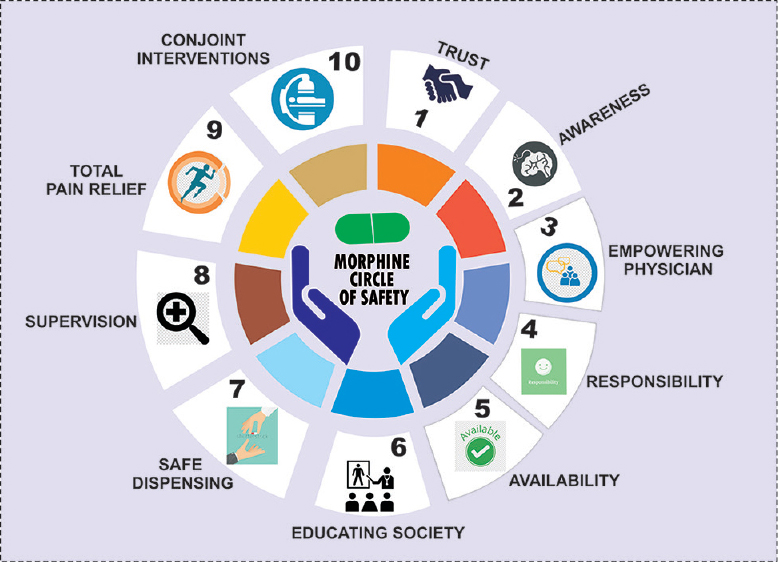Translate this page into:
Balancing Improved Opioid Supply and Safe Use of Opioids for Cancer Pain by Using “Circle of Safety”
This is an open access article distributed under the terms of the Creative Commons Attribution-NonCommercial-ShareAlike 3.0 License, which allows others to remix, tweak, and build upon the work non-commercially, as long as the author is credited and the new creations are licensed under the identical terms.
This article was originally published by Medknow Publications & Media Pvt Ltd and was migrated to Scientific Scholar after the change of Publisher.
On March 10, 2014, India saw a landmark action by the Indian Parliament; it amended India's infamous Narcotic Drugs and Psychotropic Substances Act. The amendments ensured uniformity of rules for a group of drugs called as “The essential narcotic drugs.” It also entrusted one agency, the State Drug Controller with an authority to recognize medical institute with the trained staff and the adequate infrastructure to stock and dispense these medicines.
India is now successful in implementing the uniform guidelines across all the 29 states. However, there is a need to spend energy to learn, teach, and practice safe opioid use. The simplest solution is to learn from the success stories within our own country. Few states followed the successful institutional protocols where opioids are being used effectively since last 20–25 years without major incidence of misuse and diversion.
The major challenges for safe opioid use in the Indian sociocultural context are:
-
This is an era of a global drug epidemic; we should learn lessons from the US and other developed countries about overuse or abuse of opioids
-
Who can safely handle; the use, procurement, storage, and dispensing of this medication in a country with 1.3 billion, with lack of knowledge about safe opioid use and human resources to handle opioids safely
-
How access to pain relief to rural and remote areas of India is possible, as policies impact only tertiary health care institutions.
The important aspects relating to safe opioid use is:
-
Trust between the treating doctor and the patient is essential for the treatment of cancer pain. It forms one of the foundations of contemporary medical ethics. It helps in delivering a high quality of care, mutual respect, and better sharing of information
-
Creating awareness about the use and misuse of morphine among the patients and their close associate members is very much crucial. The phobia and myths are to be addressed each time
-
Education and empowerment of physician is essential as the lack of knowledge and skills to prescribe morphine can lead to suboptimal management of pain
-
The continuous and ample supply and availability of morphine play an important role in cancer pain management. Prescribing morphine with full responsibilities with correct indications, regular follow-up, and early identification of patients at risk are features of responsible dispensing by a physician. The stringent supervision can be done by the doctor and the family members especially in patients who are at risk of developing morphine abuse
-
Universal precaution approach should be used while initial assessment of patient with cancer pain. Thereby stratifying patients according to the risk of developing substance abuse
-
As our understanding is clear that pain is not merely a resultant of tissue injury, rather, it has its own emotional, spiritual, and social components. A total pain should be addressed and managed accordingly. Psychosocial support and rehabilitation are helpful
-
The correct and timely use of interventions can lead to drastic change in pain threshold and overall management of cancer pain. It also will help in lowering the total morphine requirement
-
Hence, a teamwork can play wonder resulting into safe and correct use of morphine. It is a high time to embrace morphine with responsible hands and saying no to opiophobia.
To conclude growing incidence of opioid-induced disorders in developed countries is a lesson for India. The safe use of opioid practice for pain management will include awareness and acknowledgement of pain, strict application of patient selection criteria to start opioid therapy, education and empowerment of physicians, ascertaining responsibility, easy availability of opioids to all wherever patients need it, patient and family education, responsible dispensing, stringent supervision by family and physician, proper titration by physician and ultimately developing trust between the doctor and patient and thus learn to manage total pain by integrating pain with holistic palliative care. Therefore, there is an immediate need for widespread education, standard protocols, and uniform method of teaching among all medical professionals and administrators. It is ultimately our responsibility to use opioid safely for our patients to relieve them from their agonies by holistic pain relief [Figure 1].

- Morphine circle of safety





